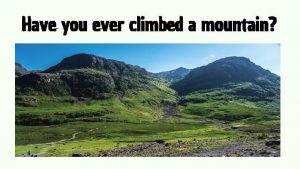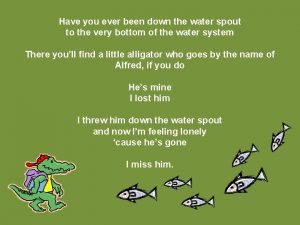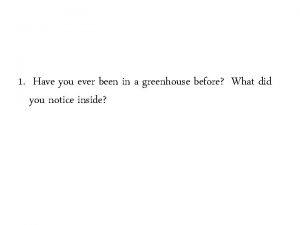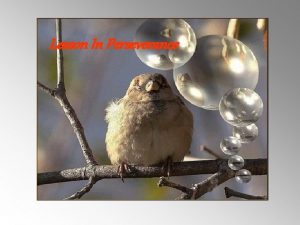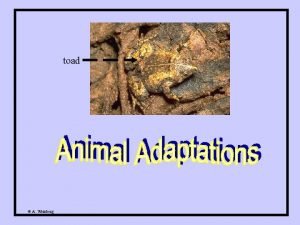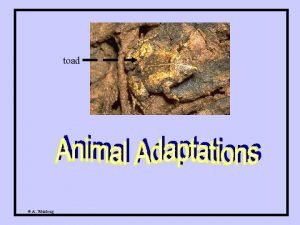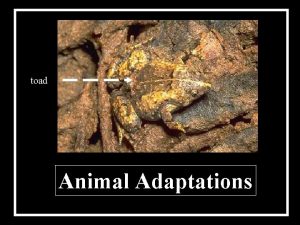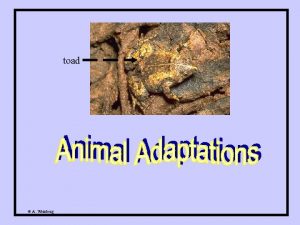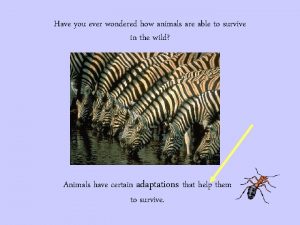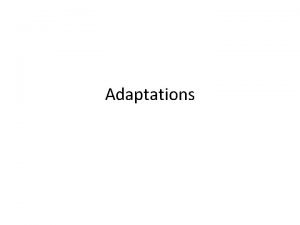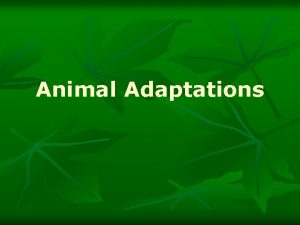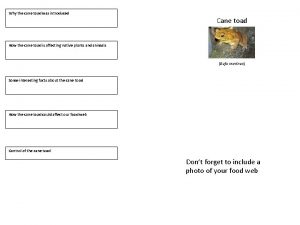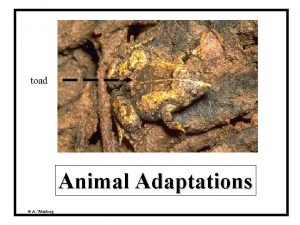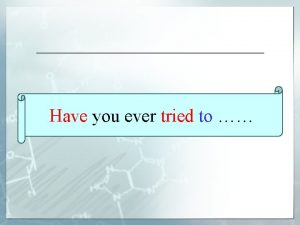toad Have you ever wondered how animals are




















- Slides: 20

toad

Have you ever wondered how animals are able to survive in the wild? Animals have certain adaptations that help them to survive.

Think about the way you dress in the winter. You don’t wear your shorts and bathing suit when it’s snowing outside! You wear warm clothes, and maybe even a hat and mittens to protect yourself from the weather.

And what if you are having a snowball fight? You probably run away from the person throwing at you, and maybe even try to sneak up on that person and throw some snowballs!

The way you dress in the winter, as well as the way that you run and hide from someone throwing snow at you are kinds of … Adaptations.

We can separate adaptations into two categories: A D Physical A P T A AND T I O N S Behavioral

Physical adaptations Hey! I’m a walking stick. I look just like a stick you’d find on the ground. © A. Weinberg are body structures that allow an animal to find and consume food, defend itself, and to reproduce its species. Physical adaptations help an animal survive in its environment.

Physical adaptation Camouflage (use of color in a surrounding) The chameleon can change its color to match its surroundings. Can you do that?

Physical adaptation Mimicry (looking or sounding like another living organism) The Viceroy butterfly uses mimicry to look like the Monarch butterfly. Can you tell them apart? I’m the Viceroy! Not poisonous Poisonous I’m the Monarch!

Physical adaptation Chemical defenses (like venom, ink, sprays)

Physical adaptations Body coverings & parts (claws, beaks, feet, armor plates, skulls, teeth) The elephant’s trunk is a physical adaptation that helps it to clean itself, eat, drink, and to pick things up.

Now let’s learn about Behavioral Adaptations… Behavioral Adaptations allow animals to respond to life needs.

Behavioral Adaptations are animals’ actions. Remember that Physical Adaptations are body structures. Each organism has unique methods of adapting to its environment by means of different actions.

We can divide Behavioral Adaptations into two groups: Instinctive Learned These behaviors happen naturally & don’t have to be learned. These behaviors must be taught.

Instinctive behaviors Methods of gathering & storing food Finding shelter happen naturally & don’t need to be learned = Defending oneself Raising young Hibernating Migrating

Learned behaviors = Obtained by interacting with the environment and cannot be passed on to the next generation except by teaching.

In this lesson, we have learned about animal adaptations. There are 2 ways to describe adaptations: Physical and Behavioral

Physical adaptations are body structures. Some examples of physical adaptations are: Camouflage Mimicry Chemical defenses Body coverings & parts

Behavioral Adaptations are animals’ actions. Behavioral Adaptations can be Instinctive or Learned.

The next time you read about an animal in the wild, or when you see on television, think about its adaptations….
 Have you ever wondered
Have you ever wondered Art of questioning examples
Art of questioning examples Have you ever wondered why some people
Have you ever wondered why some people Insidan region jh
Insidan region jh For many years people have wondered
For many years people have wondered Ever ancient ever new
Ever ancient ever new Clarified it
Clarified it Have you ever looked
Have you ever looked Ever tried ever failed no matter
Ever tried ever failed no matter Pismeni zadatak
Pismeni zadatak Shoplifting facts
Shoplifting facts Have you ever read a book
Have you ever read a book Ya aburnee arabic
Ya aburnee arabic Have you ever climbed a mountain?
Have you ever climbed a mountain? Have you ever been down
Have you ever been down Have you ever ridden a camel
Have you ever ridden a camel Have you ever climbed a mountain
Have you ever climbed a mountain Have you ever seen a greenhouse
Have you ever seen a greenhouse Have you ever been to disneyland
Have you ever been to disneyland Have you ever watched people
Have you ever watched people What is a stanza poem
What is a stanza poem













